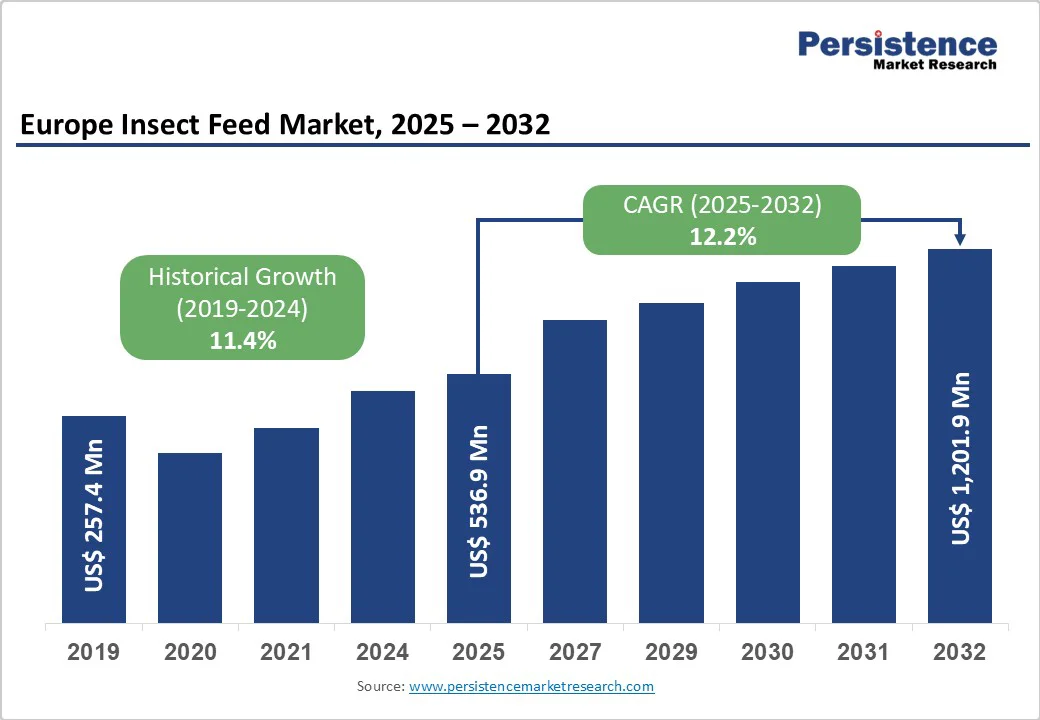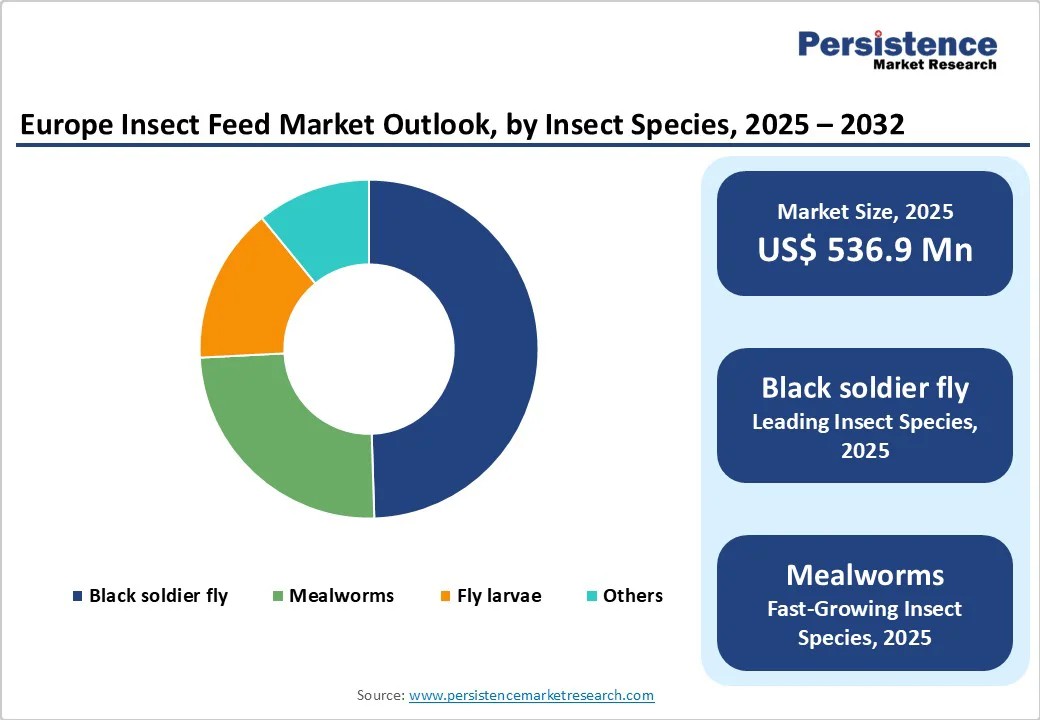ID: PMRREP35668| 187 Pages | 30 Sep 2025 | Format: PDF, Excel, PPT* | Food and Beverages

The European insect feed market size is likely to be valued at US$536.9 Mn in 2025 and is projected to reach US$1,201.9 Mn by 2032, growing at a CAGR of 12.2% during the forecast period from 2025 to 2032. The demand for sustainable, high-protein alternatives to fishmeal and soy has developed a huge market for insect feeds. Moreover, strong EU policies, the adoption of aquaculture and poultry, and rising pet food applications fuel expansion.
| Key Insights | Details |
|---|---|
|
Europe Insect Feed Market Size (2025E) |
US$536.9 Mn |
|
Market Value Forecast (2032F) |
US$ 1,201.9 Mn |
|
Projected Growth (CAGR 2025 to 2032) |
12.2% |
|
Historical Market Growth (CAGR 2019 to 2024) |
11.4% |

The European Union is increasingly prioritizing sustainability within its agricultural and feed sectors. Insects, particularly black soldier fly larvae, are gaining recognition as a sustainable source of protein for animal feed. These insects are efficient in converting organic waste into high-quality protein, aligning with the EU's circular economy objectives. For instance, the LIFE Waste2Protein project, operating across Italy, France, and Germany, transforms organic waste into insect protein, contributing to a circular feed system.
Regulatory frameworks are evolving to support this shift. The European Food Safety Authority (EFSA) has recognized the safety of insect-derived proteins, facilitating their approval for use in aquaculture and, more recently, in poultry and pig feeds. This regulatory support is crucial for scaling insect feed production.
Economically, insect farming offers cost-effective solutions by utilizing organic by-products, reducing the need for imported protein sources. The FARMYNG project in France exemplifies this approach, converting mealworms into sustainable feed products while minimizing environmental impact.
Collectively, these developments underscore the EU's commitment to integrating sustainable and circular feed solutions into its agricultural practices, positioning insect feed as a key component of future food systems.
The high production costs associated with insect farming pose a significant challenge to the scalability and competitiveness of insect-based feed in the European market. Insect meal prices currently range between €2,500 and €5,000 per metric ton, which is substantially higher than traditional feed ingredients like fishmeal, priced around €1,750 per metric ton.
These elevated costs are attributed to several factors. The infrastructure required for insect farming, including climate-controlled facilities, automated systems, and specialized equipment, demands substantial capital investment. For instance, constructing insect farming facilities involves significant expenses related to building design, air circulation, and automation systems. Additionally, operational costs encompass labor, energy, and raw materials for insect feed, all of which contribute to the overall expense.
Despite the European Union's support for insect farming, including over €1.5 billion in investments, the industry faces challenges in achieving cost competitiveness with conventional feed sources. These high production costs hinder the widespread adoption of insect-based feed, particularly among small to medium-sized farms with limited financial resources.
Addressing these cost barriers through technological advancements, economies of scale, and policy support is crucial for the sustainable growth of the insect feed market in Europe.
The European insect feed market is poised for growth through the development of functional and fortified feed products. Insects, such as black soldier fly larvae, are rich in proteins, essential amino acids, and lipids, making them suitable for enhancing the nutrition of livestock and aquaculture. For instance, black soldier fly larvae have been identified as a promising alternative to fishmeal in aquaculture feed due to their nutritional profile and sustainability.
The European Union's regulatory framework, particularly Regulation (EU) 2015/2283 on novel foods, facilitates the introduction of innovative insect-based feed products by streamlining the approval process. This regulation supports the commercialization of insect-derived ingredients, provided they meet safety and nutritional standards.
Furthermore, initiatives like the PROteINSECT project have demonstrated the feasibility of using insect larvae as a partial replacement for traditional feed ingredients, highlighting their potential in functional feed applications.
Collectively, these factors present significant opportunities for innovation in functional and fortified insect feed products, aligning with the EU's objectives for sustainable agriculture and food security.
The black soldier fly (Hermetia illucens, BSF) dominates the insect feed market, accounting for 49.5% due to its combination of high nutritional value, robust waste-conversion ability, and scalability. Government-allied sources show BSF larvae contain 40-48% crude protein on a dry matter basis and 26-38% lipids. BSF is noted in UN/FAO policy briefs as “the species with the most potential for feed”, especially for fish, poultry and pigs. Additionally, BSF bioconversion reduces the organic waste mass by ~50-70%, while producing protein-rich biomass. Because other insects (such as mealworms, crickets, and silkworms) have lower waste conversion rates, more restricted substrate tolerances, or higher rearing costs, BSF leads the market.
Aquaculture leads because replacing fishmeal with insect meal demonstrates strong performance in growth, feed conversion, and sustainability, with data particularly from government sources. Or academic? Affiliated sources. For example, a study on juvenile totoaba replaced fishmeal with Black Soldier Fly (BSF) larvae up to 50% without adverse effects on growth, digestibility, or muscle composition. In rainbow trout, replacing up to 50% fishmeal with insect meals (BSF or mealworm) yielded similar weight gain and protein utilisation compared to control feeds. Meta-analyses covering 23 freshwater and 17 marine species (from 1990–2021) found that many insect meals improved Specific Growth Rate (SGR) and reduced Feed Conversion Ratio (FCR) relative to fishmeal diets. Because aquaculture diets require high protein (often 30-55% in dry diets for carnivorous fish) and fishmeal is expensive/unsustainable, insect protein offers a viable substitute.

Germany’s insect-feed market shows growing regulatory support, small but rising production, and strong interest in circular bioeconomy models. Certified under EU law, eight insect species (including the Black soldier fly, mealworms, and house crickets) are now approved for use as processed animal protein in feeds for poultry, pigs, and aquaculture. Farms like FarmInsect are producing ~2,000 tonnes/year of BSF larvae currently, with plans to more than double next year.
Research from institutes such as Fraunhofer IME and Leibniz-IGB is developing scalable production and feed conversion metrics, supported by public funding. Public risk-assessment bodies (e.g., BfR) find that average protein contents in insects are 35-77%, fats 13-33%, making them competitive with imported soy or fishmeal. Overall, Germany is promoting insect-feed as a sustainable, legally clear substitute for animal feed, although production remains small compared to conventional protein sources.
The European insect feed market is advancing with regulatory support, industrial-scale Black Soldier Fly and mealworm production, and sustainable waste-to-protein models. Established players and startups collaborate with feed producers and farmers, leveraging automation and research partnerships. Rising demand for alternative proteins strengthens competitiveness and drives broader adoption across Europe.
The global Market is projected to be valued at US$ 536.9 Mn in 2025.
Rising demand for sustainable protein, EU regulatory approvals, and aquaculture feed needs drive Europe’s insect feed market.
The Global market is poised to witness a CAGR of 12.2% between 2025 and 2032.
Expanding aquaculture, pet food applications, waste valorization, and sustainable protein demand create major opportunities in Europe.
Major players in the global are Nextprotein, Hexafly, Entofood, Diptera Nutrition, Enviroflight, Coppens and others
| Report Attribute | Details |
|---|---|
|
Historical Data/Actuals |
2019 - 2024 |
|
Forecast Period |
2025 - 2032 |
|
Market Analysis |
Value: US$ Mn Volume: Tons |
|
Country Coverage |
|
|
Segmental Coverage |
|
|
Competitive Analysis |
|
|
Report Highlights |
|
By Insect Species
By Application
By End-user
By Country
Delivery Timelines
For more information on this report and its delivery timelines please get in touch with our sales team.
About Author